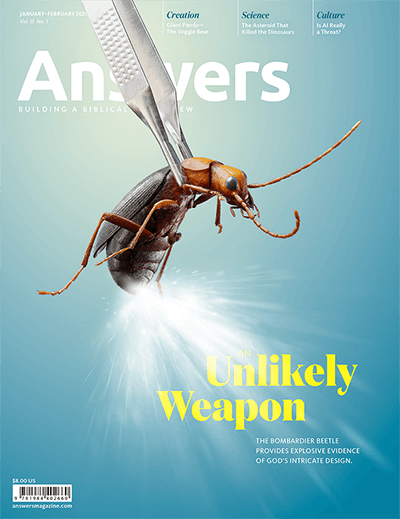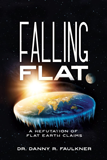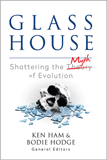
The Case of the Bloodless Bullet Wound
Limits of Science
Forensic clues do not always lead to an open and closed case.
I was one of millions who watched Ken Ham’s 2014 debate with Bill Nye “the Science Guy.” The topic was “Is creation a viable model of origins in today’s modern scientific era?” As a medical pathologist who has done extensive forensic work, I could not wait to hear what both sides would say. I was shocked to see that my field of forensic science came up right out of the gate.
Ken Ham, founder and CEO of Answers in Genesis, opened his arguments by differentiating between two kinds of science. Operational science, he said, invents medicine and technology by doing experiments in the present. Historical science, in contrast, relies on forensic science to reconstruct past events that we cannot observe, repeat, or test in the laboratory.
Then Bill Nye took his turn to speak. He denied any distinction between experimental and forensic science, saying both types are the same. The distinction existed only “in Mr. Ham’s mind.” Mr. Nye then gave the television show CSI as an example, implying that forensic science is as reliable as laboratory experimental science.
Wait a minute, I thought. Yes, forensics is a useful tool and often “gets” the bad guy. But it has severe limitations, and overestimating its power can result in a tragic miscarriage of justice, especially when it is wrongly elevated over truthful eyewitness testimony. My mind went back to a former case, where I learned this lesson all too well. I like to call it “The Case of the Bloodless Bullet Wound.”
One Body, Two Wounds, No Witnesses
In a tragic all-too-familiar scene near Chicago, a lone man entered a store and encountered a group of men. They exchanged angry words, and then the lone man ran. The others gave chase and fired shots, and the lone man lay dead on someone’s front lawn. At first the authorities had no witnesses to the actual violence, only a dead body needing explanation and justice. I was called to perform the forensic autopsy.
According to the autopsy, the victim, an otherwise healthy young man, had just two wounds, both from bullets, one in a leg, the other in his chest. The chest wound was fatal because the bullet had penetrated the heart and lungs, filling the chest cavity with several liters of blood. In striking contrast, the leg wound showed no bleeding at all, just a dry, round hole in the skin with marginal abrasion—the classic evidence of a penetrating bullet wound. The bullet was lost in muscle fibers like an arrow shot into tall grass, making it hard to recover. I spent a lot of time examining, probing, and dissecting this wound to find the bullet. The images of the wound at every angle were imprinted in my mind and made what happened afterward so surprising.
When performing a forensic autopsy, the first goal is to establish the cause and manner of death. Next, any questions about timing of wounds and death must be answered. Investigators need this information to determine the precise sequence of events leading up to death. In this case, the sequence of shots could rule out false theories and claims about the shooter’s action and intent.
Here the big question was the order of the shots. Which came first? A clue was supplied by the bloodlessness of the leg wound. The difference between the wounds was so striking as to suggest that he was shot in the leg after his heart had stopped pumping blood. It’s a time-honored maxim of forensic pathology that postmortem wounds don’t bleed. Exceptions occur, but it’s generally reliable. (If a healthy young person dies suddenly, sometimes the blood doesn’t clot right away, so postmortem wounds can bleed.)
From what I knew of the history of this case, the shots must have been fired close together. But which came first? The physical evidence seemed to rule out the leg wound first. His blood pressure would have been elevated from running, so a leg wound—even just a few seconds before a heart wound—would produce at least some bleeding. But there wasn’t any. Accordingly, my report stated that the chest wound caused death, and the leg wound was postmortem. It wasn’t very clear why a second shot to the leg should have been fired, but when guys are brandishing guns and adrenaline is flowing, they sometimes accidentally pull a trigger.
New Eyewitness Testimony
However, sometime later I received a call from the chief deputy coroner. He asked, “Hey, Doc, how sure are you about the order of those bullet wounds?”
With a sinking feeling I said, “What’s come up?”
Sure enough, an eyewitness had come forward and contradicted my careful scientific analysis. He said the deceased was first shot in the leg, bringing him down, and then shot in the chest. The shooter’s intent was thus established clearly as homicidal, leaving no room for a claim of accident or self-defense. I told the deputy coroner to heed the eyewitness testimony and disregard my report about shot order.
This case was a landmark for me in realizing the priority of eyewitness testimony. Analysis of the gunshot wounds could prove that someone died from a shooting. However, it couldn’t give the correct order of events, nor could it show the shooter’s intent. Only eyewitness testimony could do that.
Even good science cannot tell us the order and timing of creation events, nor can it necessarily tell us the character and intent of the Creator.
Similarly, science can be a useful tool to help show us that our world and the life in it was created. However, even good science cannot tell us the order and timing of creation events, nor can it necessarily tell us the character and intent of the Creator. We need the eyewitness testimony provided for us in God’s Word to know this.
Not an Easy Case
The case also reminded me that physical reality is always more complicated than our scientific theories and reconstructions. Indeed, this is just what we should expect if the universe around us is of infinite complexity, which in turn is what we should expect if a God of infinite knowledge and power created the universe.
Both operational and forensic science are valuable tools, but Mr. Nye’s view of science encourages blind faith that refuses to acknowledge the limits of science or scientists.
Contrary to Mr. Nye’s assertion, forensic science is extremely hampered by our inability to reproduce the past. Acknowledging our limits as scientists helps the cause of truth and avoids miscarriages of justice. The testimony of truthful witnesses can be invaluable. When done carefully and accurately, such testimony takes precedence over any lab work and independent analysis. Yet even then, we must be careful because humans are sinful and imperfect.
The need for eyewitness testimony is even more critical when it comes to the miraculous creation of the universe by God’s Word (John 1:1–3), which we could never recreate or study in the laboratory. God made sure to give mankind a flawless record of this central event in history so we could know the truth about our origins and our need for the Life-giver (2 Peter 1:3).
How exciting that our Lord Jesus Christ testifies truthfully and is himself the Truth (John 14:6)! Revelation 1 and 3 twice refer to him as “the faithful and true witness.” Human eyewitnesses can still make mistakes, but not Christ. He knows all that exists at every level of reality, at every point in time and eternity. This means we can—and must—trust his testimony about creation and everything else in life. He saw what happened at creation since he was there. If we trust in him, he will open our eyes to eternal truths that are hidden from all who trust their own knowledge and skills (Matthew 11:25).
Answers Magazine
January–February 2020
Unlikely Weapon: The bombardier beetle provides explosive evidence of God’s intricate design.
Browse Issue SubscribeRecommended Resources

Answers in Genesis is an apologetics ministry, dedicated to helping Christians defend their faith and proclaim the good news of Jesus Christ.
- Customer Service 800.778.3390
- © 2024 Answers in Genesis






